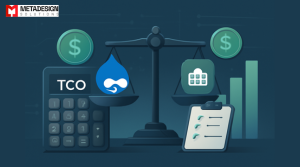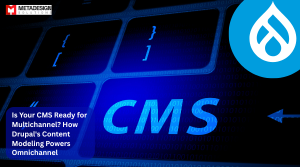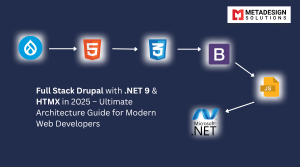In the world of digital business, scalability is key. Whether you’re managing a large e-commerce site, a media platform, or a high-traffic website, your platform needs to be able to handle rapid growth and unpredictable traffic spikes. If your website struggles during peak traffic periods or performance drops when your audience grows, it’s time to consider how your platform architecture is built.
Enter Drupal—one of the most powerful, scalable content management systems (CMS) available today. With its robust architecture and enterprise-grade performance, Drupal can handle even the most demanding websites and applications. In this article, we’ll dive into when and why your platform might need Drupal’s architectural power to stay ahead of the competition.
1. What Makes Drupal a Scalable Solution?
Drupal has long been recognized for its flexibility and scalability, making it the go-to choice for high-traffic websites, enterprise web development, and businesses aiming to handle large volumes of content and users.
Key features that make Drupal development services inherently scalable include:
- Modular Architecture: Drupal’s modular structure allows you to enable only the features you need, keeping your website lean and efficient. You can also easily add or remove modules based on growing requirements without worrying about performance degradation.
- Database Optimization: With support for highly efficient database indexing and caching solutions, Drupal ensures that data retrieval is fast, even with a high volume of simultaneous users.
- Flexible Content Management: Drupal offers extensive control over how content is structured and served. It’s highly adaptable for large-scale content management, which is crucial for media platforms, news sites, and large e-commerce operations.
- Advanced Caching: Drupal comes with built-in caching mechanisms like Drupal Cache API and Varnish integration, helping to store frequently accessed data and reducing server load, ensuring faster load times and better user experience during traffic spikes.
2. When Does Your Platform Need Drupal’s Scalability Power?
Not every website needs the full power of Drupal’s architecture. However, certain types of websites will benefit significantly from Drupal’s scalability features. These include:
High-Traffic Websites
If your website is experiencing high or unpredictable traffic spikes, such as during seasonal sales, product launches, or viral content campaigns, Drupal is built to handle these demands. Drupal’s caching, load balancing, and database optimization techniques allow it to handle massive amounts of concurrent users with minimal performance degradation.
E-Commerce Sites with Massive Product Catalogs
For large e-commerce platforms, managing product inventories, user transactions, and data analytics can become complex as your site scales. Drupal is designed to accommodate large-scale product catalogs and complex customer data. The flexibility of its content architecture means that developers can efficiently organize and display product information, while maintaining high performance even during peak shopping seasons.
Media and Publishing Sites with Heavy Content Load
Media sites often feature dynamic content—news articles, blogs, images, videos—that is constantly being updated. With high-frequency content publication and massive user engagement, these sites require a CMS that can not only manage heavy content loads but also deliver it quickly to a global audience. Drupal’s ability to manage diverse content types, multilingual capabilities, and powerful media integration makes it ideal for these kinds of sites.
Enterprise Web Development Projects
For large corporations that require a CMS capable of managing vast amounts of data, serving thousands of concurrent users, and integrating with other enterprise systems, Drupal’s scalability shines. With its ability to integrate with ERP systems, CRM platforms, and third-party tools, Drupal ensures that your website remains a powerful hub for all your enterprise content and applications.
Is Your Platform Hitting a Wall?
Assess your future growth needs and deploy the enterprise-grade architecture that can handle it all.
3. How Drupal Handles Massive Traffic Spikes
One of the most critical aspects of any platform’s scalability is its ability to handle traffic spikes without compromising performance. Let’s break down how Drupal manages massive traffic spikes:
Load Balancing
Drupal is often deployed in a load-balanced environment, which means that traffic is distributed across multiple servers, reducing the load on any single server. This approach ensures that your site can continue to perform smoothly even as the number of visitors increases.
Database Scaling
Drupal’s architecture supports horizontal database scaling, allowing you to distribute the database load across multiple servers. By breaking up the database into smaller, more manageable pieces, Drupal can handle large amounts of concurrent database queries, which is critical during high-traffic events.
Caching Layers
Caching plays a critical role in reducing server load and improving response times. Drupal supports multiple levels of caching:
- Page Caching: For anonymous visitors, Drupal can cache entire pages, reducing the need to regenerate them with every request.
- Entity Caching: For authenticated users, Drupal can cache content entities like nodes, blocks, and views to reduce the amount of processing required for each page load.
- External Caching Tools: Integration with tools like Varnish, Redis, and Memcached further enhances Drupal’s ability to serve content quickly during traffic surges.
Content Delivery Networks (CDN)
Drupal integrates seamlessly with CDNs to deliver static assets, such as images, CSS, and JavaScript, from servers closer to your users, reducing latency and improving load times.
4. When to Consider Drupal for Enterprise Web Development
If your platform is growing rapidly or is already experiencing the challenges of scaling, it’s time to consider whether Drupal’s architecture can help you meet those needs.
- Performance Demands: If your platform needs to deliver content fast—especially in high-traffic situations—Drupal’s ability to scale horizontally and handle heavy content traffic will help you maintain performance.
- Global Audience: If you’re serving a global audience with varied content needs, Drupal’s multilingual support and multi-site capabilities make it easy to maintain and distribute content to a wide range of users without compromising on performance.
- Future-Proofing: As your business continues to grow, you need a platform that can grow with you. Drupal’s scalable infrastructure ensures your CMS will evolve alongside your business, allowing you to handle increased traffic, new content types, and changing user needs without rebuilding from scratch.
5. Conclusion: Is Drupal the Right Choice for Your Growing Website?
Drupal’s scalability features make it a top choice for websites that need to handle high volumes of traffic, large catalogs of data, and complex content strategies. Whether you are running a high-traffic e-commerce site, a media platform, or a large-scale enterprise project, Drupal’s robust architecture ensures that your site can manage growth without sacrificing performance.
For businesses facing scalability challenges, Drupal offers the architectural power to stay agile, flexible, and responsive to growing demands.
Ready to Scale with Drupal?
If you’re ready to explore how Drupal’s scalability can support your high-traffic website or enterprise web development needs,Talk to Our Drupal Experts today! Our Drupal development team is here to help you build a platform that performs under pressure.
Relevant Hashtags:
#Drupal #Scalability #HighTraffic #EcommerceDevelopment #EnterpriseWebDevelopment #WebPerformance #DrupalDevelopment #CMS #MediaSites #WebScalability #TrafficSpikes #DrupalSolutions



